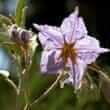Background
- Belladonna is an herb that has been used for centuries for a variety of indications, including headache, menstrual symptoms, peptic ulcer disease, inflammation, and motion sickness. Belladonna is known to contain active agents with anticholinergic properties, such as the tropane alkaloids atropine, hyoscine (scopolamine), and hyoscyamine.
- There are few available studies of belladonna alone for any indication. Most research has evaluated belladonna in combination with other agents, such as ergot alkaloids or barbiturates, or in homeopathic (diluted) preparations. Preliminary evidence suggests possible efficacy in combination with barbiturates for the management of symptoms associated with irritable bowel syndrome. However, there is currently insufficient scientific evidence regarding the use of belladonna for this or any other indication.
- Common adverse effects include dry mouth, urinary retention, flushing, pupillary dilation, constipation, confusion, and delirium. Many of these effects may occur at therapeutic doses.
References
Natural Standard developed the above evidence-based information based on a thorough systematic review of the available scientific articles. For comprehensive information about alternative and complementary therapies on the professional level, go to . Selected references are listed below.
- Balzarini A, Felisi E, Martini A, et al. Efficacy of homeopathic treatment of skin reactions during radiotherapy for breast cancer: a randomised, double-blind clinical trial. Br Homeopath J 2000;89(1):8-12.
View Abstract - Bergmans M, Merkus J, Corbey R, et al. Effect of Bellergal Retard on climacteric complaints: a double-blind, placebo-controlled study. Maturitas 1987;9:227-234.
View Abstract - Bettermann H, Cysarz D, Portsteffen A, et al. Bimodal dose-dependent effect on autonomic, cardiac control after oral administration of Atropa belladonna. Auton Neurosci 2001;90(1-2):132-137.
View Abstract - Ceha LJ, Presperin C, Young E, et al. Anticholinergic toxicity from nightshade berry poisoning responsive to physostigmine. The Journal of Emergency Medicine 1997;15(1):65-69.
View Abstract - Duncan G, Collison DJ. Role of the non-neuronal cholinergic system in the eye: a review. Life Sci 2003;72(18-19):2013-2019.
View Abstract - Kahn A, Rebuffat E, Sottiaux M, et al. Prevention of airway obstructions during sleep in infants with breath- holding spells by means of oral belladonna: a prospective double-blind crossover evaluation. Sleep 1991;14(5):432-438.
View Abstract - King JC. Anisotropine methylbromide for relief of gastrointestinal spasm: double- blind crossover comparison study with belladonna alkaloids and phenobarbital. Curr Ther Res Clin Exp 1966;8(11):535-541.
View Abstract - Lichstein J, Mayer JD. Drug therapy in the unstable bowel (irritable colon). A 15-month double-blind clinical study in 75 cases of response to a prolonged-acting belladonna alkaloid-phenobarbital mixture or placebo. J Chron Dis 1959;9(4):394-404.
View Abstract - Rhodes JB, Abrams JH, Manning RT. Controlled clinical trial of sedative-anticholinergic drugs in patients with the irritable bowel syndrome. J Clin Pharmacol 1978;18(7):340-345.
View Abstract - Shanafelt TD, Barton DL, Adjei AA, et al. Pathophysiology and treatment of hot flashes. Mayo Clin Proc 2002;77(11):1207-1218.
View Abstract - Stieg RL. Double-blind study of belladonna-ergotamine-phenobarbital for interval treatment of recurrent throbbing headache. Headache 1977;17(3):120-124.
View Abstract - Tsiskarishvili NV, Tsiskarishvili TsI. [Colorimetric determination of eccrine sudoriferous glands functional condition in case of hyperhidrosis and their correction by belladonna]. Georgian Med News 2006;(140):47-50.
View Abstract - Walach H, Koster H, Hennig T, et al. The effects of homeopathic belladonna 30CH in healthy volunteers -- a randomized, double-blind experiment. J Psychosom Res 2001;50(3):155-160.
View Abstract - Whitmarsh TE, Coleston-Shields DM, Steiner TJ. Double-blind randomized placebo-controlled study of homoeopathic prophylaxis of migraine. Cephalalgia 1997;17(5):600-604.
View Abstract







